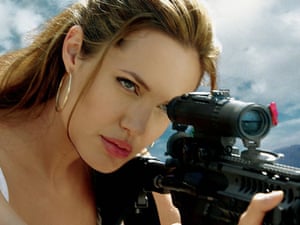The scene starts with a blurred long shot which creates a sense of mystery as the figure standing in the hallway is dark and unclear. As the figure moves closer it transitions to a medium close up which reveals the identity of James Bond and allows the audience to see the serious expression on his face. This sets the mood of the scene, helping the consumer understand that something dangerous may happen as the medium close up also allows us to focus on certain aspects in mise-en-scene, for example the use of props as the audience can see that there is a gun positioned ready to shoot. The over the shoulder shots of the subject as he moves allows the audience to anticipate what is going to happen next as they are not shown everything in the frame until after the character has seen it himself. The point of view shot as Bond walks into the room allows the audience to see the unfolding of events at the same as he does. This could prompt a bigger audience reaction as the events feel real for the consumer as they are forced to put themselves in Bond's position.
The low angle shot as James Bond walks out of the room as the man in the chair is bleeding creates the impression that Bond was the dominant one of the two and emphasises his strength. The high angle shot as he is walking down the stairs forces us to focus our attention on him as we are unable to see much else in the shot as it is dark and shadowy. The handheld shots when showing the characters in the car gives a more realistic effect as it is makes it seem as if you are in the car with them as the shot is quite shaky, mirroring the movement of the car. The wide shot as the cars drive through crowds of people reveals some of the setting, allowing the audience to get a better understanding of the situation and evaluate the situation to make predictions of what will happen next.
The use of tracking shots, such as during the motorbike chase, helps the audience focus on the events as they are following the action as it happens. The fast pace of the camera movement also fits the music as it becomes more intense, placing a feeling of tension and anxiety within the consumer. The crane shots as they are driving on top of the buildings and on top of the train allow the audience to clearly see what is happening as they see more of the setting and allows them to see the action all at once as both characters are in the frame rather than cutting between each character separately. This gives the consumer the opportunity to take in what is happening and get a better idea of how the narrative might develop.
 This is a medium long shot as you can almost see the characters full body but some of his legs are cropped out. This shot allows us to clearly see the character and exposes some of the setting which gives the audience a clue as to where the scene will be set. It is also taken from a low angle which helps emphasise the characters power and dominance.
This is a medium long shot as you can almost see the characters full body but some of his legs are cropped out. This shot allows us to clearly see the character and exposes some of the setting which gives the audience a clue as to where the scene will be set. It is also taken from a low angle which helps emphasise the characters power and dominance. This is a medium close up as you can still see some of the characters shoulders. This shot allows the audience to clearly see the characters emotion as it focuses on her serious expression. It also allows the audience to make an assumption as to what the movie about and what genre it may be as there is a clear image of weaponry.
This is a medium close up as you can still see some of the characters shoulders. This shot allows the audience to clearly see the characters emotion as it focuses on her serious expression. It also allows the audience to make an assumption as to what the movie about and what genre it may be as there is a clear image of weaponry. This still is taken from a central angle and is a long shot as it shows all of each character and all characters can be seen around the table. The focus is equally shared between them as none of them have been zoomed in on specifically.
This still is taken from a central angle and is a long shot as it shows all of each character and all characters can be seen around the table. The focus is equally shared between them as none of them have been zoomed in on specifically. This image is taken from a high angle. This makes the girl appear weak and vulnerable as being looked down on makes her seem even smaller and inferior.
This image is taken from a high angle. This makes the girl appear weak and vulnerable as being looked down on makes her seem even smaller and inferior.
Comments
Post a Comment